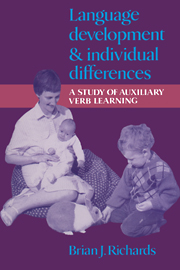Book contents
- Frontmatter
- Contents
- List of figures
- List of tables
- Preface
- Symbols used in transcription
- Pronunciation table
- PART I INTRODUCTORY SECTIONS
- Introduction
- 1 The auxiliary and the young language learner
- 2 Rate of auxiliary verb learning in thirty-three children
- PART II INDIVIDUAL DIFFERENCES AND AUXILIARY VERB LEARNING IN SEVEN CHILDREN
- PART III ENVIRONMENTAL INFLUENCES AND INDIVIDUAL DIFFERENCES IN AUXILIARY VERB LEARNING
- Notes
- References
- Index
Introduction
from PART I - INTRODUCTORY SECTIONS
Published online by Cambridge University Press: 19 September 2009
- Frontmatter
- Contents
- List of figures
- List of tables
- Preface
- Symbols used in transcription
- Pronunciation table
- PART I INTRODUCTORY SECTIONS
- Introduction
- 1 The auxiliary and the young language learner
- 2 Rate of auxiliary verb learning in thirty-three children
- PART II INDIVIDUAL DIFFERENCES AND AUXILIARY VERB LEARNING IN SEVEN CHILDREN
- PART III ENVIRONMENTAL INFLUENCES AND INDIVIDUAL DIFFERENCES IN AUXILIARY VERB LEARNING
- Notes
- References
- Index
Summary
Why should a book about individual differences choose to focus on auxiliary verb learning?
When I was first attached to the Bristol Longitudinal Study of Language Development in the autumn of 1983, I had no clear idea of the direction in which an investigation into individual differences would take me. Nevertheless, a survey of the existing child language literature highlighted the auxiliary system as a feature on which children varied in a number of ways which might possibly be related.
The auxiliary seemed to be of particular interest in three ways. Firstly, it appeared that a high frequency of auxiliaries at a certain stage might be associated with a distinctive ‘style’ or ‘route’ of language development, or with strategies to communicate at a level beyond the child's current stage of linguistic competence. Secondly, Gordon Wells' paper ‘Learning and using the auxiliary verb in English’ (Wells, 1979a) showed extensive variation in the rate of emergence of auxiliaries which he interpreted as evidence of children's differing analytical abilities in the development of form classes. Thirdly, evidence from experimental and naturalistic studies suggested that the auxiliary and the structures in which it participated were particularly sensitive to environmental influences. A statistical relationship between the frequency of Yes/No questions (Y/Ns) heard by children and subsequent rate of auxiliary verb growth emerged as the most stable finding from correlational studies of the effects of input on rate of language development.
Information
- Type
- Chapter
- Information
- Language Development and Individual DifferencesA Study of Auxiliary Verb Learning, pp. 3 - 4Publisher: Cambridge University PressPrint publication year: 1990
